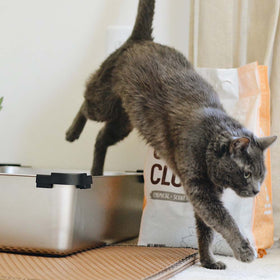
Ways to Improve Allergy Symptoms in Dogs: A Holistic Approach
Just like humans, dogs can develop reactions to environmental factors, like pollen or dust, or to certain foods. We’re going to discuss some natural and effective ways to improve your dog’s allergy symptoms, focusing on desensitization, skin and gut health, and topical solutions that bring relief.
Desensitize with Local Honey or Pollen
One of the most natural and effective ways to help your dog combat seasonal allergies is by introducing them to raw local honey or bee pollen.
Local bee pollen and unpasteurized honey contain trace amounts of pollen from local plants, which can help desensitize your dog’s immune system. Feeding your dog small amounts can accustom their body to allergens in the environment, gradually reducing the severity of their allergy symptoms.
Ideally, you’ll want to start this protocol before allergy season begins. If you choose to use pollen over honey, make sure you follow the instructions on how to introduce it slowly.
Support Skin Health with Omega-3 Fatty Acids
A high quality omega-3 fatty acid not only feeds the skin, helping it to be healthier and stronger, it also helps reduce inflammation and relieve allergy symptoms.
The quality of oil is especially important for older dogs and dogs with allergies or sensitivities. Two of our favourites are Nordic Naturals Omega-3 Pet and Ograx-3, which is available through your integrative veterinarian.
Providing a high quality EFA with EPA and DHA is integral for allergy pups, but the additional benefits are far-reaching.
Support a Healthy Gut
A healthy gut plays a huge role in supporting your dog’s immune system. A balanced diet rich in fibre, moisture, and fresh foods is essential to maintaining a healthy gut, and a strong gut barrier helps reduce inflammation and enhances your dog’s ability to fight off allergens.
Balance is key because essential nutrients, like zinc, and the correct ratio of fats impact skin health and the body’s ability to fight symptoms.
Support the gut by feeding a moisture-rich diet with plenty of gut-friendly foods, like fibre and fermented foods.
Use Natural Medicines for Allergy Relief
Milk thistle has natural antihistamine properties that can help reduce the body’s allergic response, and nettle works naturally to stop the release of histamines in the first place. (Nikki receives nettle tea poured onto her food and a scoop of freeze dried veggies with nettles at each meal when she starts to itch.)
Quercetin, a flavonoid, stimulates the immune system and blocks histamine release to alleviate symptoms like itching and inflammation.
Chinese herbal blends, like Steve Marsden’s (DVM) Cessorex, feed the skin and help balance the immune system. Since allergies are either an overreaction or underreaction of the immune system, this step in particular can be very effective.
Topical Solutions to Relieve Itchy Skin and Hot Spots
Topical solutions help remove surface allergens (preventing them from being ingested) and provide immediate relief. Regular bathing, paw soaks, and daily wipe downs can help remove allergens from your dog’s skin and coat.
If your dog is free from symptoms, we recommend using the purest unscented shampoo you can find. Our favourite is 4-Legger’s 5-ingredient hypoallergenic aloe shampoo. If your dog’s skin is inflamed, try a cooling wash.
In some cases, you may need a stronger wash including something like chlorhexidine. In this case, we strongly urge using this on affected areas only. If you need to use it on more than 50% of your dog, it’s advisable to spray the skin afterwards with a probiotic spray. You can make this yourself with Love Bugs and a little water. Mix only what you need for the immediate application.
A Proactive and Holistic Approach to Managing Dog Allergies
By taking a proactive approach to your dog’s health, you can significantly reduce allergy symptoms. It’s important to understand that no amount of bathing and supplements will rid your dog of allergies if their only source of nutrition is an ultra-processed, dry diet. If you can’t make the switch to 100% fresh, take a look at our free guide to fresh toppers.









